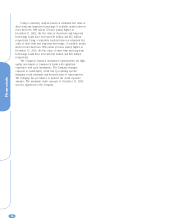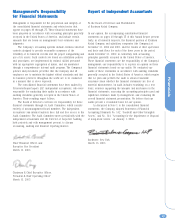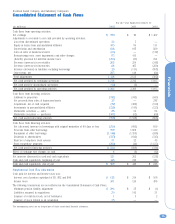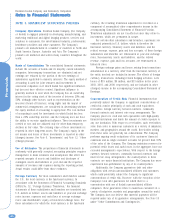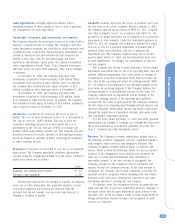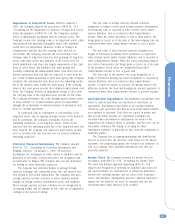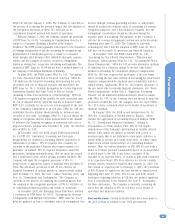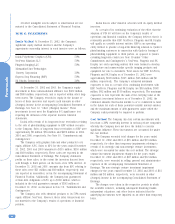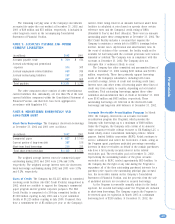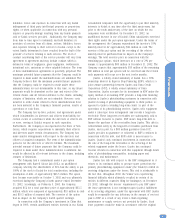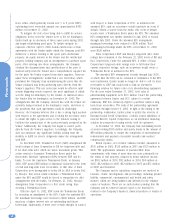Kodak 2002 Annual Report Download - page 48
Download and view the complete annual report
Please find page 48 of the 2002 Kodak annual report below. You can navigate through the pages in the report by either clicking on the pages listed below, or by using the keyword search tool below to find specific information within the annual report.
Financials
48
Earnings Per Share Basic earnings-per-share computations
are based on the weighted-average number of shares of common
stock outstanding during the year. Diluted earnings-per-share
calculations reflect the assumed exercise and conversion of
employee stock options that have an exercise price that is below
the average market price of the common shares for the
respective periods.
Options to purchase 26.8 million and 43.7 million shares of
common stock at weighted-average per share prices of $58.83
and $61.30 for the years ended December 31, 2002 and 2001,
respectively, were outstanding during the years presented but
were not included in the computation of diluted earnings per
share because the options’ exercise price was greater than the
average market price of the common shares for the respective
periods.
Comprehensive Income SFAS No. 130, “Reporting
Comprehensive Income,” establishes standards for the reporting
and display of comprehensive income and its components in
financial statements. SFAS No. 130 requires that all items
required to be recognized under accounting standards as
components of comprehensive income be reported in a financial
statement with the same prominence as other financial
statements. Comprehensive income consists of net earnings, the
net unrealized gains or losses on available-for-sale marketable
securities, foreign currency translation adjustments, minimum
pension liability adjustments and unrealized gains and losses on
financial instruments qualifying for hedge accounting and is
presented in the accompanying Consolidated Statement of
Shareholders’ Equity in accordance with SFAS No. 130.
Stock-Based Compensation The Company accounts for its
employee stock incentive plans under Accounting Principles Board
(APB) Opinion No. 25, “Accounting for Stock Issued to Employees”
and the related interpretations under Financial Accounting
Standards Board (FASB) Interpretation No. 44, “Accounting for
Certain Transactions Involving Stock Compensation.” Accordingly,
no stock-based employee compensation cost is reflected in net
income from continuing operations as all options granted had an
exercise price equal to the market value of the underlying
common stock on the date of grant. In accordance with SFAS No.
148, “Accounting for Stock-Based Compensation – Transition and
Disclosure,” the following table illustrates the effect on net
income from continuing operations and earnings per share from
continuing operations as if the Company had applied the fair
value recognition provisions of SFAS No. 123, “Accounting for
Stock-Based Compensation,” to stock-based employee
compensation.
(in millions, except per share data)
Year Ended December 31
2002 2001 2000
Net income from continuing
operations, as reported $ 793 $ 81 $ 1,407
Deduct: Total stock-based
employee compensation expense
determined under fair value
method for all awards, net
of related tax effects (105) (79) (61)
Pro forma net income from
continuing operations $ 688 $ 2 $ 1,346
Earnings per share from
continuing operations
Basic — as reported $ 2.72 $ .28 $ 4.62
Basic — pro forma $ 2.36 $ .01 $ 4.41
Diluted — as reported $ 2.72 $ .28 $ 4.59
Diluted — pro forma $ 2.36 $ .01 $ 4.41
The 2002 total stock-based employee compensation expense
amount of $105 million, net of taxes, includes a net of tax
expense impact of $34 million representing the unamortized
compensation cost of the options that were canceled in
connection with the 2002 voluntary stock option exchange
program. See Note 19, “Stock Option and Compensation Plans.”
Segment Reporting The Company reports net sales, operating
income, net income, certain expense, asset and geographical
information about its operating segments. Public companies report
information about their business activities, which meets the criteria
of a reportable segment. Reportable segments are components of
an enterprise for which separate financial information is available
that is evaluated regularly by the chief operating decision maker in
deciding how to allocate resources and in assessing performance.
The Company has three reportable segments and All Other. See
Note 22, “Segment Information” for a discussion of the change in
the Company’s operating structure in 2001.
Recently Issued Accounting Standards In June 2001, the
FASB issued SFAS No. 143, “Accounting for Asset Retirement
Obligations.” SFAS 143 addresses the financial accounting and
reporting for obligations associated with the retirement of tangible
long-lived assets and the associated asset retirement costs.
SFAS 143 applies to legal obligations associated with the
retirement of long-lived assets that result from the acquisition,
construction, development and/or normal use of the assets.
SFAS 143 requires that the fair value of a liability for an asset
retirement obligation be recognized in the period in which it is
incurred if a reasonable estimate of fair value can be made. The
fair value of the liability is added to the carrying amount of the
associated asset, and this additional carrying amount is expensed
over the life of the asset. The Company is required to adopt


